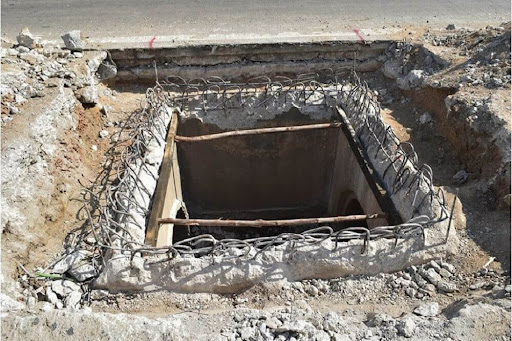Types of Concrete Repairs
by Admin

Types of Concrete Repairs
There are two basic types of Concrete repairs. Full-depth repairs replace damaged concrete with fresh concrete. Partial-depth repairs involve cutting along the edges of damaged concrete and cleaning the reinforced steel. Both types require professional repair workers to carefully assess the damage and recommend the best method of remedial action. Full-depth repairs are ideal for areas that are structurally compromised or have experienced extensive weathering. Partial-depth repairs are also beneficial in cases where only small areas of damage are present.
Full-depth repair
There are several benefits of full-depth concrete repair. It can address problems such as transverse cracks, corner breaks, deteriorated joints, punchouts, and D-Cracking. The full-depth repair process requires minimal disruption to the existing concrete, resulting in a uniform and stable platform. A seasoned professional can guide you through the process. To avoid costly mistakes, learn how to choose the right repair method for your project. Full-depth repairs are necessary if a portion of a concrete slab is missing. Cracks, utility cuts, and other damage to the pavement require this approach. After identifying the damaged area, the repair crew can start by removing a section of the existing pavement and compacting the base material. Next, the patched section must be placed and finished. Often, full-depth repairs are required when a sub-base structure has deteriorated due to water intrusion or poor stabilization.
A contractor must use a template to delineate the limits of a repair. They must repair the entire width of a lane, including the top layer of hot mix asphalt. In addition, a Contractor must remove a portion of the concrete in accordance with the provisions of OPSS 510. The outer boundary of the repair area must be sawed cut full depth and cannot extend more than 250 mm into the adjacent concrete. Any overcuts shall be filled with a proprietary product acceptable to the Ministry.
The full-depth repair process includes removing a slab or concrete joint. For concrete repairs, a minimum of 1/2 inch of unsound concrete must be removed. If the damage is more than this, a full slab must be replaced. A contractor must perform a full slab replacement at his expense. The process also requires cleaning the cavity with high-pressure water jets and compressed air. If the existing concrete is damaged, the contractor must cut it off with a concrete saw, or the repair is considered incomplete.
After removing the old concrete, the proprietary concrete repair material must be finished flush with the surface of the repaired concrete. Excess material should be removed immediately, and the new concrete must be cured according to the manufacturer's recommendations. The insert will prevent a bond at the face of the joint and will form a reservoir for the joint sealant. Once the joint sealant has been applied, the cavity shall be filled with Grade III epoxy resin mortar. The elastomeric concrete mixture shall be proportioned and mixed. The new concrete should be installed in a consolidated state and cured as directed by the manufacturer.
Epoxy injection repair
When a crack in your concrete slab is too wide to be repaired by conventional methods, it's time to consider an epoxy injection repair. This method can be done with a homemade kit or by calling a professional concrete repair company. The goal is to restore structural integrity to the concrete and resist moisture penetration. This type of repair is generally used for horizontal or vertical cracks as well as over-head cracks, where conventional methods are unable to penetrate.
To inject epoxy into a crack, you must first caulk the surface of the crack with a capping paste. This paste helps bond injection ports to the concrete. Once the ports are attached, you'll need to install a series of injection ports that will deliver the resin to the crack. Ports are usually six to ten inches apart and can include a reservoir port or a port manifold.
Before beginning the epoxy injection process, you must clean the surface to eliminate any debris or pollutants. Make sure to avoid impacting the crack with dirt or other debris since this can result in the application of improper epoxy. If you can, blow out the crack with clean compressed air before proceeding. Remember that it's better to use epoxy in a dry crack than a wet one. Water seeping from the crack must also be stopped to ensure the success of the procedure.
During an epoxy injection process, you should apply a paste-over that is at least 3/16" thick and one inch wide. This helps prevent voids under the pressure of the injection process. You should also make sure that the crack passes through the concrete surface so that it doesn't leak any epoxy. Once you're satisfied with the results, you can proceed with the repair. And don't forget to ask your contractor to give you a free quote.
These are short, rigid plastic tubes that are bonded to the surface. They are often placed between cracks in concrete, which reduces labor time and cleanup. The injection port should be spaced one inch apart for each inch of wall thickness. You should also make sure the epoxy injection procedure is safe for occupants of the building. A good way to check this is by calling the building owner's insurance company.
Before applying epoxy injection, you should clean the crack thoroughly with a wire brush. You can also use water and compressed air to remove debris. Once the surface is clean, you can mount the injection ports. Make sure that the crack is dry and that the area is dry. If water is trickling, it needs to be taken care of at the source. If the area is too wet, it's best to leave area dry.
Concrete restoration
The demand for concrete restoration is growing across the world. Old structures are prone to deterioration and may require extensive structural repairs. This is due to poor maintenance and aging, but it can also be caused by earthquakes. Poor building design and poor maintenance can lead to early deterioration. The following are common causes of premature deterioration and their treatment. Choosing the right concrete restoration company is essential for preserving the architectural structure of an old building.
A professional company will use proper materials to restore concrete. Concrete restoration materials are available for all types of concrete surfaces, including walls, floors, and facades. Concrete repair supplies come in various types, including epoxies, grouts, and epoxy injection. Concrete restoration contractors are able to recommend the best method for restoring a damaged area. There are four common types of concrete restoration: epoxy injection, polyurethane grouting, leveling, and total removal.
Another benefit of concrete restoration is its cost. This method is significantly less expensive than new construction. It gives the appearance of a brand-new concrete structure. It also prevents structural issues from getting out of control, which will lead to property damage. By choosing concrete restoration, you'll be saving money while preserving the beauty and function of your concrete structure. There are many other benefits of concrete restoration. Once you choose the right company, you can rest easy knowing you're getting a high-quality product at a reasonable price.
Another benefit of concrete restoration is its natural thermal resistance. This material keeps the room cooler in the winter and warmer in the summer, reducing the need for air conditioners and other energy-inefficient appliances. Unfortunately, a damaged concrete surface can trap air and moisture, which raises energy bills and reduces efficiency. An untreated concrete surface can worsen the problem. By contrast, a properly restored concrete surface provides excellent insulation and structural soundness.
When a concrete surface becomes too weak, it is no longer slip-resistant, which can make a building unsafe. Concrete restoration is often necessary if the structural integrity of a building is compromised. Seawater and airborne chemicals can cause concrete to lose its traction and make it slick, making it dangerous to occupy. In addition to the physical threat, the damage posed by concrete can also cause serious health hazards, especially for people living in apartments.
A properly restored concrete surface can last between 50 and 100 years. By regularly performing restoration, the material can be maintained to prevent deterioration and premature aging. By addressing the problem early, small damage can be remedied before it becomes a bigger problem. Moreover, repairing damaged concrete is better than waiting until it gets worse. This also prevents dangerous conditions for pedestrians, vehicles, and buildings. The long-term effects of concrete restoration will be worthwhile.
Types of Concrete Repairs There are two basic types of Concrete repairs. Full-depth repairs replace damaged concrete with fresh concrete. Partial-depth repairs involve cutting along the edges of damaged concrete and cleaning the reinforced steel. Both types require professional repair workers to carefully assess the damage and recommend the best method of remedial action. Full-depth…
Recent Posts
- The Benefits of Choosing Dentures as a Solution for Restoring Your Smile in Las Vegas
- Understanding the Core Principles and Approaches of Integrative Medicine in Modern Healthcare
- Essential Tips for First-Time Home Buyers in Dallas, Texas
- The Power of B2B BNPL: Combating Buyer Default and Sales Delay with Revenue-Based Financing
- 2 Gen Realty LLC: Your Premier Partner for Real Estate Services in Waco and Beyond
